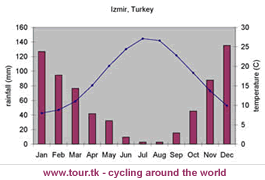Temperate Rainforest
Date: February 1-20
City: Sydney, Australia
 |
| Climate Diagram
--My last and final stop put me in Sydney, Australia. While I was there in February, the temperature was a comfortable average of 72 degrees Fahrenheit. This moderate temperature is one of the characteristics of the temperate rainforest biome.
Packing List:
-Umbrella -Hiking Boots
-Extra Socks -Layers of Clothing -Insect Repellent
Adventures:
With my last stop on this biome quest, I was pleased to find myself in Australia. I realized that the temperate rainforest could be found in northern California, but with this being my last biome to visit, I wanted it to be in a different country. This biome can be found on the west coast and is influenced by the ocean currents. There are normally mild summers and winters, while the summers are foggy and the winters are rainy. I was there in February, which was a rather wet month. The single most unique feature of this biome is without a doubt the trees that grow. The climate of this biome allows large trees to grow such as fir, spruce, cedar, and hemlocks. The soil is left low in nutrients because the vegetation quickly takes in all excess nutrients before the soil can take it in. The moist climate allows for moss and ferns to also grow abundantly.
The common mammals located in this biome are deer, coyotes, and bears. While these are all typical mammals that are found in any forest, there are also other animals that I found here that are more specific to this biome. The rainy climate of this biome creates the perfect place for slugs and snails to live. There are also all kinds of birds that take home in the temperate rainforest.
 |









